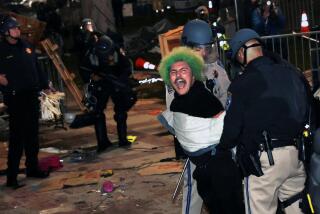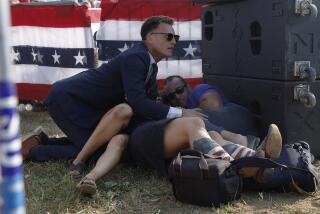Fighting the Bullets on New Year’s Eve
- Share via
With billboards, television spots and speeches, Los Angeles police are seeking again to ram home a basic law of physics as New Year’s Eve approaches: Bullets fired into the air hurtle back to earth with deadly force.
“There is no need to risk someone else’s life to have a good time on New Year’s Eve,” City Councilman Joel Wachs said Monday, joining acting Police Chief Martin Pomeroy and City Atty. James K. Hahn to publicize the city’s seven-day ban on ammunition sales for the week leading up to, and including, New Year’s Day.
Their appearance was the culmination of a decade-long publicity blitz drumming in the message that celebratory bullets fired randomly into the air can kill, and those who shoot them can spend three years in prison.
The aim is to head off criminals more mindless than malicious--the drunken revelers who fire at the sky in the mistaken belief that their bullets vanish harmlessly into the heavens.
In fact, the laws of physics dictate that a bullet fired up will come barreling down at virtually the same speed it left the muzzle. “There is a little lost for air friction, but not much. Bullets are very aerodynamic,” said UCLA physics staff member Martin Simon.
Perfectly vertical shots will return to earth close to where they were fired; pistol bullets fired at even a slight angle will follow an arc that could bring them down blocks away. Rifle shots can travel several miles.
The result has been a slew of gunshot wounds and close calls over the years--and occasional deaths.
The current campaign began around the same time that police officers at the 77th Street precinct got fed up with the hail of bullets, and put a tape recorder in the back of a patrol car on New Year’s Eve.
The gunshots they recorded helped make their point vividly to policy makers, and a cause was born. “The tape sounded like Beirut,” said Wachs, author of the ammunition ban.
Shooting into the air was made a felony in 1988, and the ban on ammunition sales, gifts or loans--also in force for the week of the Fourth of July--came in 1990. Since then, the “What goes up, will come down” campaign has steadily gained momentum.
Everyone from the school district to celebrities such as James Garner have pitched in over the years. The LAPD’s $37,000 advertising campaign this year includes radio ads in English, Spanish and Korean.
This year, schoolchildren throughout Los Angeles Unified were asked to participate in essay and poster contests. Nine-year-old Tiara Hoyt of Carson and Gardena fifth-grader Eric Hernandez were the respective winners.
In Eric’s brightly colored entry, a man in the center of the poster fires a gun, while a man walking a dog in one corner and a huddled family in the other look up fearfully at the sky.
Opinions differ as to how many people have fallen victim to random gunfire. An LAPD spokesman said the department has been unable to come up with reliable figures and that there are discrepancies in some tallies.
One study by King/Drew Medical Center physicians said 38 people died from celebratory gunfire on New Year’s and the Fourth of July from 1985 to 1992. Police put the number at fewer than half a dozen in the same period.
In recent years, though there have been some injuries, no one is believed to have died, Pomeroy said.
One preliminary count based on gunfire-related calls recorded at police dispatch centers showed 600 such incidents at New Year’s last year, down from 788 in 1992, but slightly up from 567 in 1995. Thirty-one arrests were made, down from 43 in 1995.
Even the best available statistics don’t give a clear picture of how effective the campaign has been, police said.
But ordinary officers such as Mike Shea, who works in the 77th Street precinct, believe the campaign has made an enormous difference.
“It’s incredible,” said Shea. “The 77th on New Year’s Eve isn’t what it used to be. There used to be automatic weapon fire all night long.”
For officers, these are some of the most worrisome of holiday calls. In past years, patrol cars have been hit by bullets, and in 1988, a falling slug pierced the windshield of a moving car and wounded an officer, though not seriously, said Sgt. Doug Young.
Police now are so familiar with the hazard that “for the five minutes before and after midnight, we drive under a freeway overpass,” said Officer Henry Gutierrez of the West Valley precinct.
In recent years, police have assigned specially trained teams to respond to these calls. “Take cover and try to hear where it’s coming from,” is how one officer described their tactics.
The ammo sales ban is not applauded by all, especially not by ammunition vendors such as Jim Ness, general manager of Firing Line Indoor Shooting Ranges, which operates a range in Northridge. “Anyone who would shoot up into the air is a total idiot to start with,” he said, but added the ammunition ban serves only to shift sales from Los Angeles stores to those outside city limits, easily reachable from most parts of the city.
Still, Officer Shea said the worst he expects as he prepares for his upcoming New Year’s Eve shift is, “Some guy who’s drunk a few who fires five or six rounds, then runs back into his house.”
“We won’t have automatic weapons in the street like we used to.”
More to Read
Sign up for Essential California
The most important California stories and recommendations in your inbox every morning.
You may occasionally receive promotional content from the Los Angeles Times.










